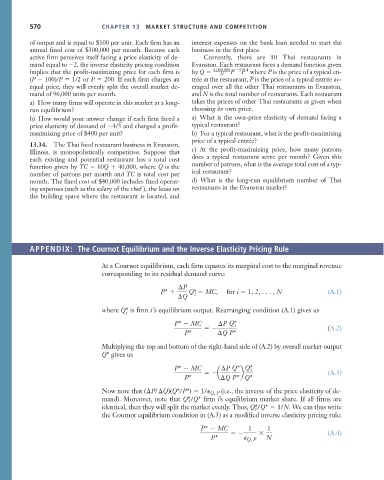Page 596 - Microeconomics, Fourth Edition
P. 596
c13marketstructureandcompetition.qxd 7/30/10 10:44 AM Page 570
570 CHAPTER 13 MARKET STRUCTURE AND COMPETITION
of output and is equal to $100 per unit. Each firm has an interest expenses on the bank loan needed to start the
annual fixed cost of $300,000 per month. Because each business in the first place.
active firm perceives itself facing a price elasticity of de- Currently, there are 10 Thai restaurants in
mand equal to 2, the inverse elasticity pricing condition Evanston. Each restaurant faces a demand function given
implies that the profit-maximizing price for each firm is by Q 4,000,000 5 P 4 where P is the price of a typical en-
P
N
(P 100)/P 1/2 or P 200. If each firm charges an trée at the restaurant, is the price of a typical entrée av-
P
equal price, they will evenly split the overall market de- eraged over all the other Thai restaurants in Evanston,
mand of 96,000 units per month. and N is the total number of restaurants. Each restaurant
a) How many firms will operate in this market at a long- takes the prices of other Thai restaurants as given when
run equilibrium? choosing its own price.
b) How would your answer change if each firm faced a a) What is the own-price elasticity of demand facing a
price elasticity of demand of 4/3 and charged a profit- typical restaurant?
maximixing price of $400 per unit? b) For a typical restaurant, what is the profit-maximizing
price of a typical entrée?
13.34. The Thai food restaurant business in Evanston,
Illinois, is monopolistically competitive. Suppose that c) At the profit-maximizing price, how many patrons
each existing and potential restaurant has a total cost does a typical restaurant serve per month? Given this
function given by TC 10Q 40,000, where Q is the number of patrons, what is the average total cost of a typ-
number of patrons per month and TC is total cost per ical restaurant?
month. The fixed cost of $40,000 includes fixed operat- d) What is the long-run equilibrium number of Thai
ing expenses (such as the salary of the chef ), the lease on restaurants in the Evanston market?
the building space where the restaurant is located, and
APPENDIX: The Cournot Equilibrium and the Inverse Elasticity Pricing Rule
At a Cournot equilibrium, each firm equates its marginal cost to the marginal revenue
corresponding to its residual demand curve:
¢P
P* Q* MC, for i 1, 2, . . . , N (A.1)
i
¢Q
where Q* i is firm i’s equilibrium output. Rearranging condition (A.1) gives us
P* MC ¢P Q* i
(A.2)
P* ¢Q P*
Multiplying the top and bottom of the right-hand side of (A.2) by overall market output
Q* gives us
P* MC ¢P Q* Q* i
a b (A.3)
P* ¢Q P* Q*
Now note that (¢P/¢Q)(Q*/P*) 1/ Q, P (i.e., the inverse of the price elasticity of de-
mand). Moreover, note that Q*/Q* firm i’s equilibrium market share. If all firms are
i
identical, then they will split the market evenly. Thus, Q* i /Q* 1/N. We can thus write
the Cournot equilibrium condition in (A.3) as a modified inverse elasticity pricing rule:
P* MC 1 1
(A.4)
P* Q, P N

